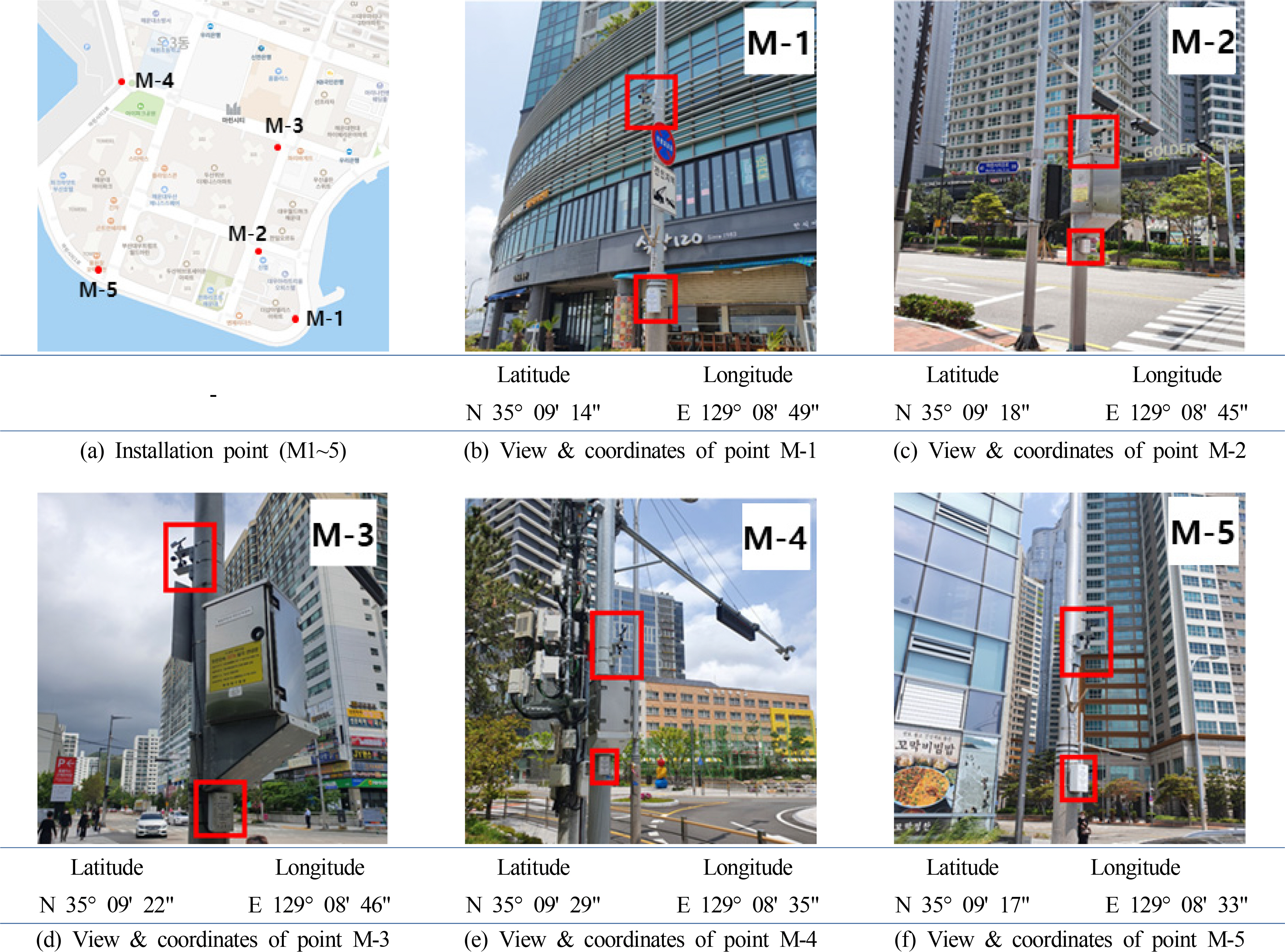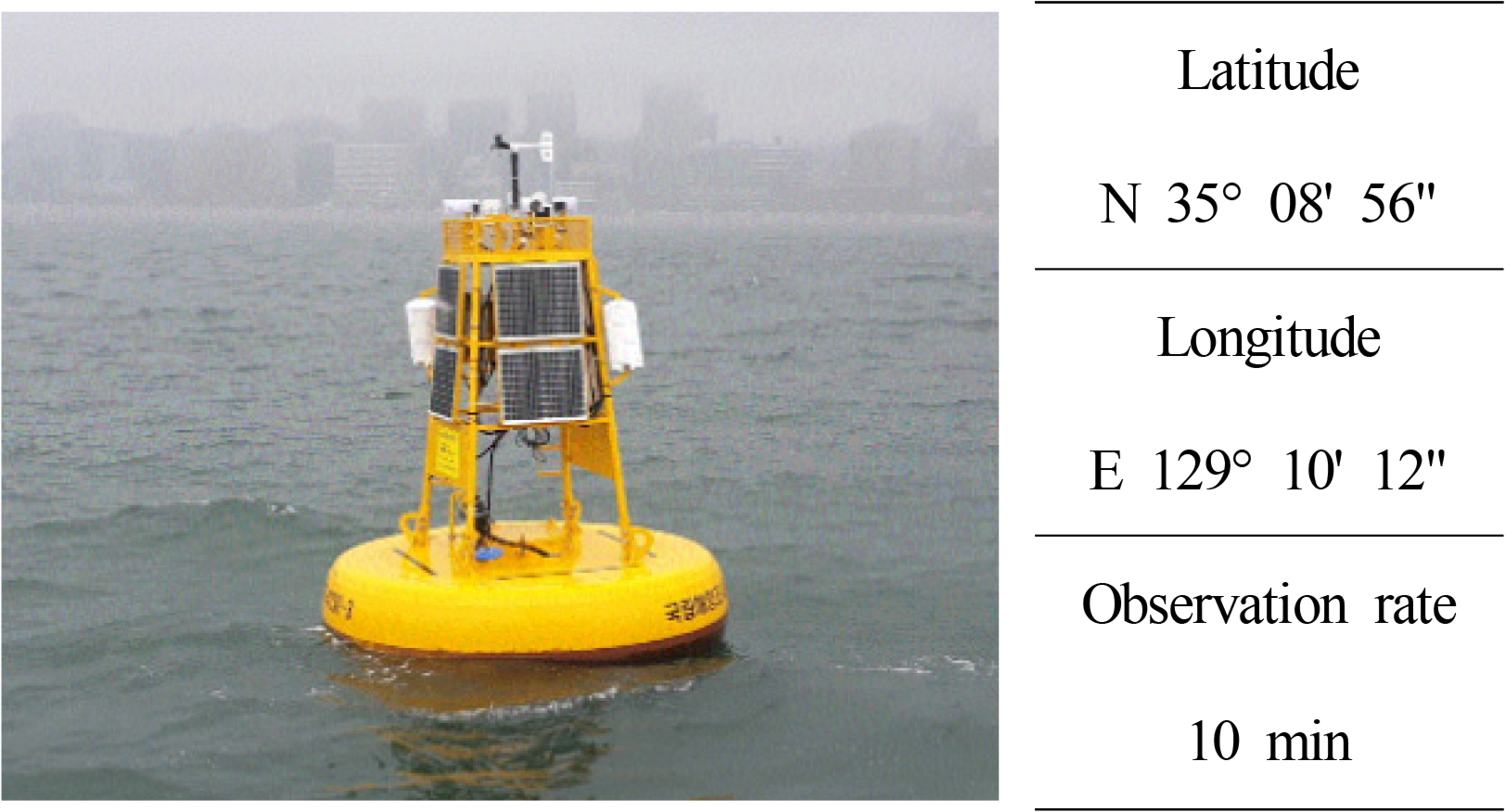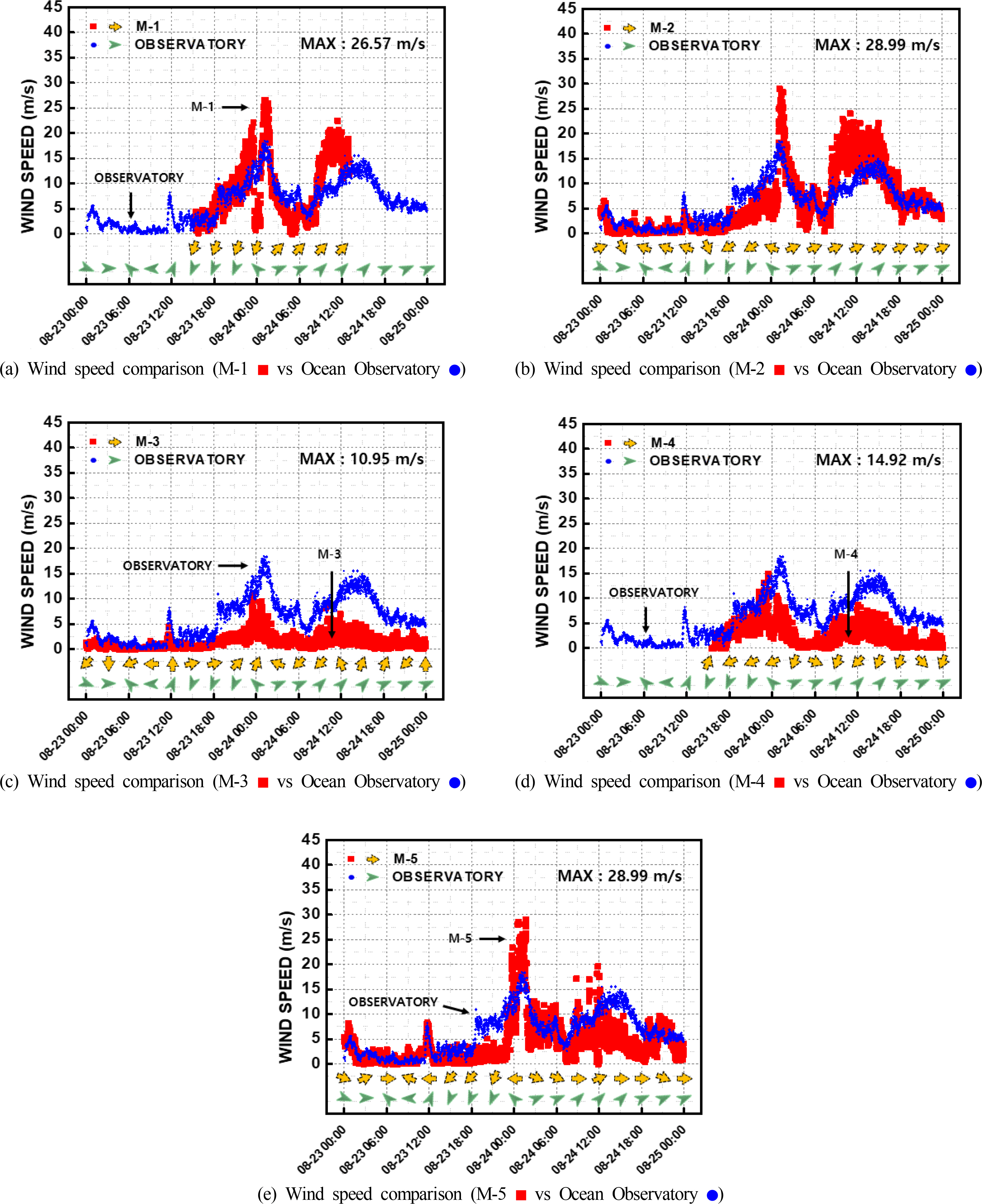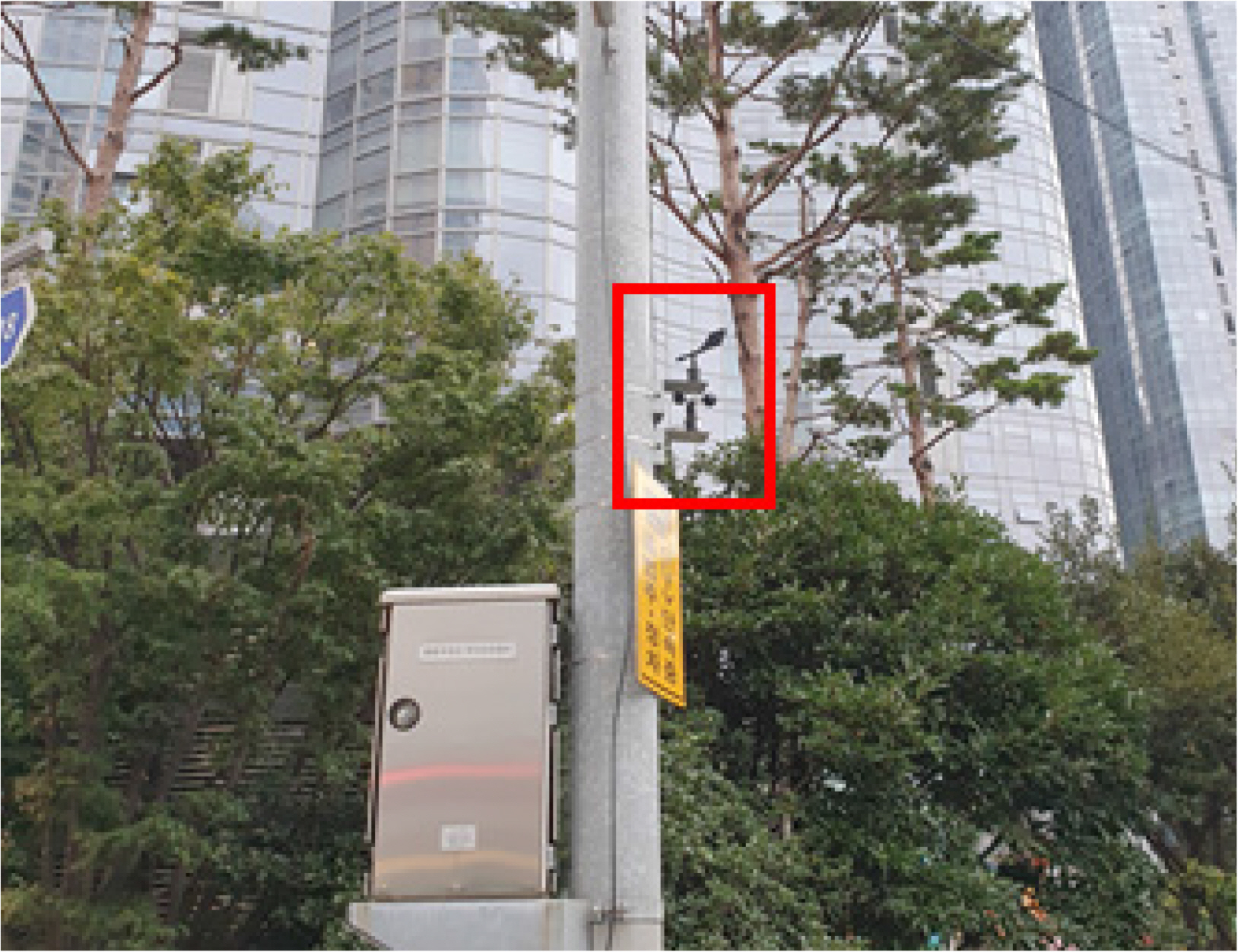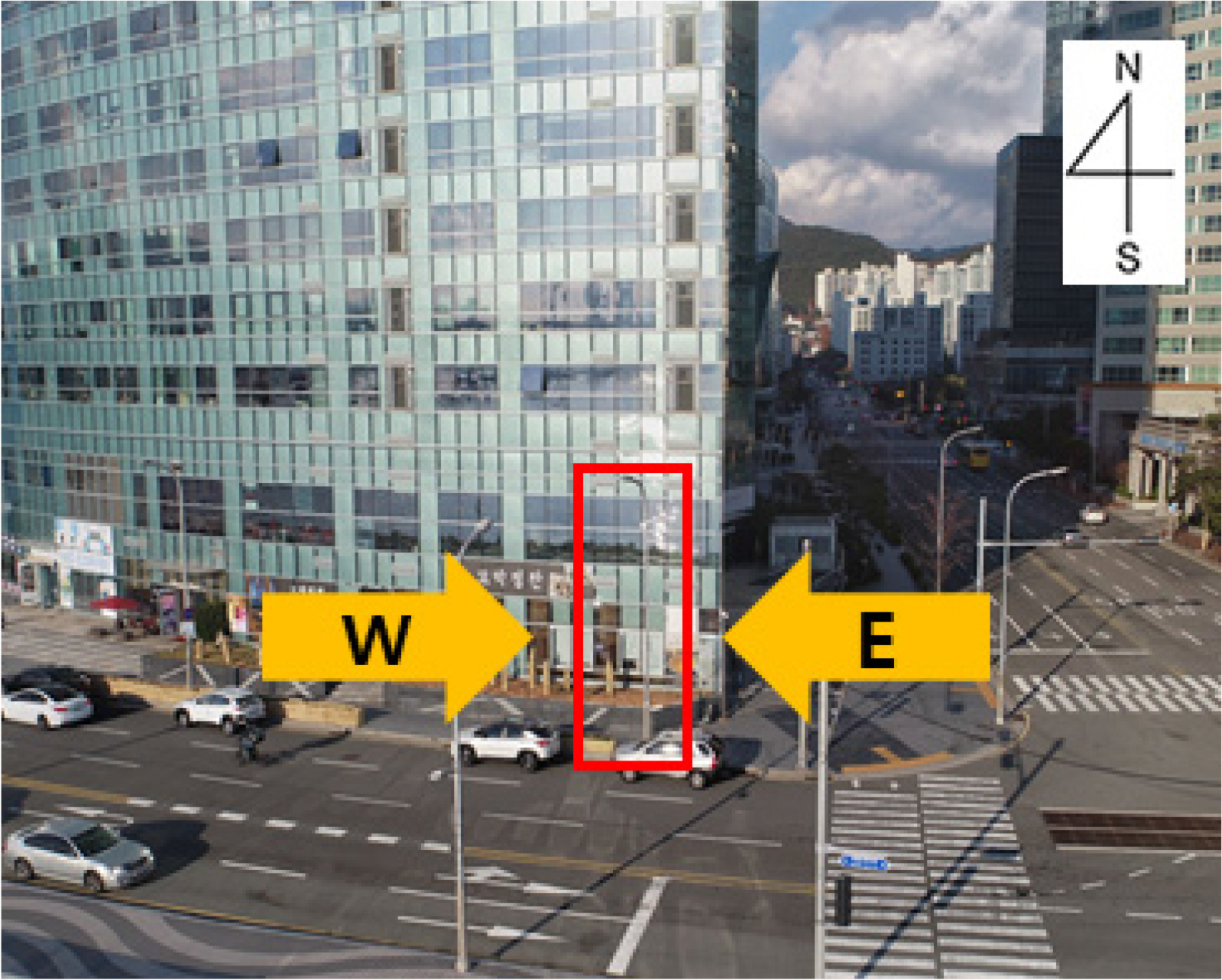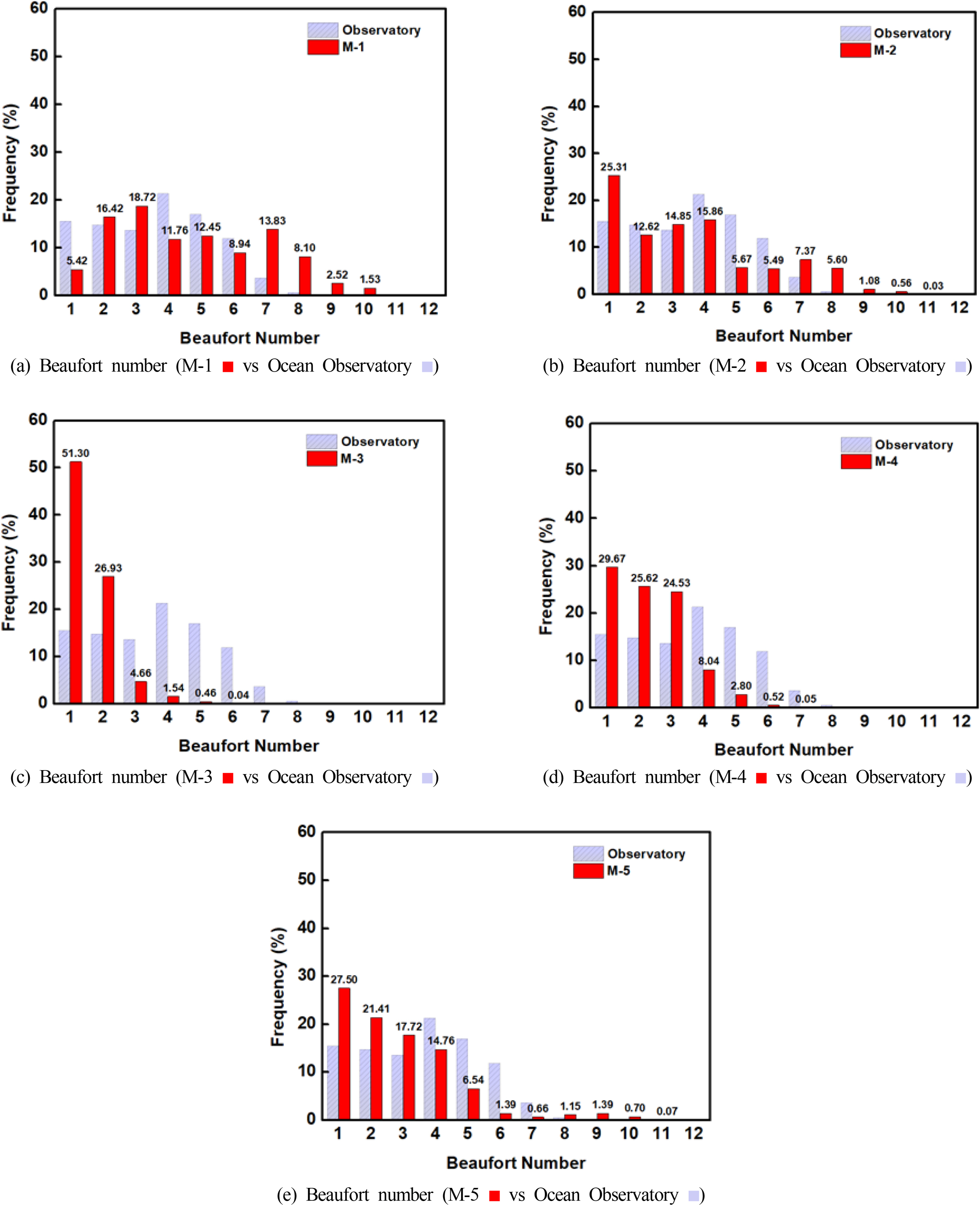1. Introduction
2. Definition of Building Wind
3. On-site Monitoring
3.1 Research Site and Monitoring Points
3.2 Monitoring Equipment and Method
3.3 The 12th Typhoon OMAIS
4. Monitoring Results
4.1 One-minute Average Wind Speed of the Ocean Observatory
 ) and the 1-h average wind direction to identify the atmospheric wind direction (
) and the 1-h average wind direction to identify the atmospheric wind direction ( ), which were provided by the Haeundae beach ocean observatory. At the ocean observatory, a maximum wind speed of 18.5 m/s (southwest) was recorded as the first peak at 01:07 on August 24th after the invasion of the typhoon. At 06:00 on August 24th, a maximum wind speed of 15.5 m/s (southwest, west-southwest) was recorded as the second peak as the wind speed increased again even after the typhoon changed into an extratropical cyclone. The wind direction did not show a certain tendency when the observatory was in the indirect impact range of the typhoon. After 14:00 on August 24th when it was in the direct impact range of the typhoon, however, the wind direction was observed in the order of northeast → southeast → southwest, showing an obvious clockwise direction as in an area located on the right side of a typhoon’s path.
), which were provided by the Haeundae beach ocean observatory. At the ocean observatory, a maximum wind speed of 18.5 m/s (southwest) was recorded as the first peak at 01:07 on August 24th after the invasion of the typhoon. At 06:00 on August 24th, a maximum wind speed of 15.5 m/s (southwest, west-southwest) was recorded as the second peak as the wind speed increased again even after the typhoon changed into an extratropical cyclone. The wind direction did not show a certain tendency when the observatory was in the indirect impact range of the typhoon. After 14:00 on August 24th when it was in the direct impact range of the typhoon, however, the wind direction was observed in the order of northeast → southeast → southwest, showing an obvious clockwise direction as in an area located on the right side of a typhoon’s path.4.2 Marine City Wind Speed and Wind Speed Ratio (Relative Evaluation)
 ) and 1-h average wind direction (
) and 1-h average wind direction ( ) measured at five points (M-1 to M-5) in Marine City. Fig. 7 shows the wind speed ratio at each point (
) measured at five points (M-1 to M-5) in Marine City. Fig. 7 shows the wind speed ratio at each point ( ,
,
 ) by applying Eq. (1). As for the calculation of the wind speed ratio, time points at which the wind speed was not measured were excluded. Some wind speed ratios were excessive (5 to 25), and this appears to be because the wind speed measured at the ocean observatory was relatively low. Therefore, in this study, the wind speed ratio was calculated for cases where the wind speed at the ocean observatory was 2 m/s or higher to derive the wind speed ratio at significant wind speed.
) by applying Eq. (1). As for the calculation of the wind speed ratio, time points at which the wind speed was not measured were excluded. Some wind speed ratios were excessive (5 to 25), and this appears to be because the wind speed measured at the ocean observatory was relatively low. Therefore, in this study, the wind speed ratio was calculated for cases where the wind speed at the ocean observatory was 2 m/s or higher to derive the wind speed ratio at significant wind speed.4.2.1 Point M-1
4.2.2 Point M-2
4.2.3 Point M-3
4.2.4 Point M-4
4.2.5 Point M-5
4.3 Beaufort Number at Marine City Points (Absolute Evaluation)
 ). The numbers ranged from 0 to 10, and their proportions were 5.42%, 16.42%, 18.72%, 11.76%, 12.45%, 8.94%, 13.83%, 8.10%, 2.52%, and 1.53%, respectively. The mode was found to be 3 (gentle breeze) and the maximum value was 10 (storm). Compared to the wind speed data at the ocean observatory, Beaufort numbers 1, 4, 5, and 6 showed a decrease in frequency, whereas Beaufort numbers 2, 3, 7, and 8 presented an increase in frequency. Wind speeds corresponding to Beaufort numbers 9 and 10 (20.8 to 28.4 m/s), which were not observed at the ocean observatory, were observed here.
). The numbers ranged from 0 to 10, and their proportions were 5.42%, 16.42%, 18.72%, 11.76%, 12.45%, 8.94%, 13.83%, 8.10%, 2.52%, and 1.53%, respectively. The mode was found to be 3 (gentle breeze) and the maximum value was 10 (storm). Compared to the wind speed data at the ocean observatory, Beaufort numbers 1, 4, 5, and 6 showed a decrease in frequency, whereas Beaufort numbers 2, 3, 7, and 8 presented an increase in frequency. Wind speeds corresponding to Beaufort numbers 9 and 10 (20.8 to 28.4 m/s), which were not observed at the ocean observatory, were observed here. ). The numbers ranged from 0 to 11, and their proportions were 25.31%, 12.62%, 14.85%, 15.86%, 5.67%, 5.49%, 7.37%, 5.60%, 1.08%, 0.56%, and 0.03%, respectively. The mode was found to be 1 (light air) and the maximum value was 11 (violent storm). Compared to the wind speed data at the ocean observatory, Beaufort numbers 2, 4, 5, and 6 showed a decrease in frequency, whereas numbers 1, 3, 7, and 8 presented an increase in frequency. Wind speeds corresponding to Beaufort numbers 9, 10, and 11 (20.8 to 32.6 m/s), which were not observed at the ocean observatory, were observed here.
). The numbers ranged from 0 to 11, and their proportions were 25.31%, 12.62%, 14.85%, 15.86%, 5.67%, 5.49%, 7.37%, 5.60%, 1.08%, 0.56%, and 0.03%, respectively. The mode was found to be 1 (light air) and the maximum value was 11 (violent storm). Compared to the wind speed data at the ocean observatory, Beaufort numbers 2, 4, 5, and 6 showed a decrease in frequency, whereas numbers 1, 3, 7, and 8 presented an increase in frequency. Wind speeds corresponding to Beaufort numbers 9, 10, and 11 (20.8 to 32.6 m/s), which were not observed at the ocean observatory, were observed here. ). The numbers ranged from 0 to 6, and their proportions were 51.30%, 26.93%, 4.66%, 1.54%, 0.46%, and 0.04%, respectively. The mode was found to be 1 (light air) and the maximum value was 6 (strong breeze). Compared to the wind speed data at the ocean observatory, Beaufort numbers from 3 to 6 showed a decrease in frequency, whereas numbers 1 and 2 had a significant increase in frequency.
). The numbers ranged from 0 to 6, and their proportions were 51.30%, 26.93%, 4.66%, 1.54%, 0.46%, and 0.04%, respectively. The mode was found to be 1 (light air) and the maximum value was 6 (strong breeze). Compared to the wind speed data at the ocean observatory, Beaufort numbers from 3 to 6 showed a decrease in frequency, whereas numbers 1 and 2 had a significant increase in frequency. ). The numbers ranged from 0 to 7, and their proportions were 29.67%, 25.62%, 24.53%, 8.04%, 2.80%, 0.52%, and 0.05%, respectively. The mode was found to be 1 (light air) and the maximum value was 7 (near gale). Compared to the wind speed data at the ocean observatory, Beaufort numbers from 4 to 7 showed a decrease in frequency, whereas numbers from 1 to 3 presented a significant increase in frequency.
). The numbers ranged from 0 to 7, and their proportions were 29.67%, 25.62%, 24.53%, 8.04%, 2.80%, 0.52%, and 0.05%, respectively. The mode was found to be 1 (light air) and the maximum value was 7 (near gale). Compared to the wind speed data at the ocean observatory, Beaufort numbers from 4 to 7 showed a decrease in frequency, whereas numbers from 1 to 3 presented a significant increase in frequency. ). The numbers ranged from 0 to 11, and their proportions were 27.50%, 21.41%, 17.72%, 14.76%, 6.54%, 1.39%, 0.66%, 1.15%, 1.39%, 0.70%, and 0.07%, respectively. The mode was found to be 1 (light air) and the maximum value was 11 (violent storm). Beaufort numbers from 4 to 7 showed a decrease in frequency, whereas numbers 1, 2, 3, and 8 had an increase in frequency. Wind speeds corresponding to Beaufort numbers 9, 10, and 11 (20.8 to 32.6 m/s), which were not observed at the ocean observatory, were observed at this point.
). The numbers ranged from 0 to 11, and their proportions were 27.50%, 21.41%, 17.72%, 14.76%, 6.54%, 1.39%, 0.66%, 1.15%, 1.39%, 0.70%, and 0.07%, respectively. The mode was found to be 1 (light air) and the maximum value was 11 (violent storm). Beaufort numbers from 4 to 7 showed a decrease in frequency, whereas numbers 1, 2, 3, and 8 had an increase in frequency. Wind speeds corresponding to Beaufort numbers 9, 10, and 11 (20.8 to 32.6 m/s), which were not observed at the ocean observatory, were observed at this point.5. Conclusion
Among points M-1, M-2, and M-5 at which the wind speed was significantly increased, point M-2 had the highest wind speed, showing a maximum wind speed of 28.99 m/s and a maximum wind speed ratio of 2.92. Different building wind patterns were observed depending on the location characteristics of each point. At points M-1 and M-5, which were located on the side of a high-rise building, the main wind direction was found to be parallel to the building direction and the wind speed ratio was high when the atmospheric wind direction was parallel to the building outer wall direction. The wind direction at point M-2, which was located at an intersection, was highly correlated with that at the ocean observatory located in the sea, and the wind speed ratio was high when the atmospheric wind direction was west. This appears to be because high-rise buildings were located on the west side of point M-2. At points M-3 and M-4, the wind speed ratio was found to be less than 1 and the wind speed rather decreased even though they were located in areas where high-rise buildings were densely located. This appears to be due to the influence of the trees planted near the observation equipment. A previous study (Kim et al., 2013) analyzed the wind-proof effect of planting windbreak forest through a wind tunnel test, and it confirmed that the windbreak forest has the effect of decreasing the wind speed by at least 47%. In this study, the wind-proof effect of trees could also be observed through actual monitoring data.
When the absolute values of the wind speed were analyzed through the Beaufort wind scale, it was found that Beaufort numbers from 7 to 11, which belong to the dangerous wind speed range, showed an increase in frequency at points M-1, M-2, and M-5, where the wind speed was significantly increased. Beaufort numbers from 1 to 3, which correspond to low wind speeds, also showed an increase in frequency. This indicates that the wind speed was decreased by the blockage effect of buildings or increased by the building wind effect depending on the conditions. Thus, further research is required on various variables that cause building wind. At points M-3 and M-4, where the wind speed decreased due to the wind-proof effect of trees, the degree of decrease in wind speed could be quantitatively identified because Beaufort numbers of 4 and above showed a significant decrease in frequency, whereas those from 1 to 3 presented a significant increase in frequency.
Based on the above results, the areas with risk due to building wind are shown in Fig. 13. As the number of measurement points is small compared to the range of the research site, it is difficult to identify the risk level for all sections in the site. It seems necessary to perform high-density monitoring by installing more monitoring points or to utilize computational fluid dynamics (CFD) to identify the risk level for the entire range of the research site. It is also considered necessary to conduct further research with high reliability through cross-analysis between monitoring and CFD.
In addition, 1-min average data were used for a comparison with the wind speed data of the ocean observatory, but it is considered necessary to analyze the 3-s average (instantaneous wind speed) or 1-s average wind speed data due to the characteristics of the building wind, which may cause gusts and damage within a short period of time. As an example, at point M-2 where the highest wind speed was observed, the maximum wind speed was calculated to be 48.24 m/s when the 3-s average wind speed was used and 53.20 m/s when the 1-s average wind speed was used. These were 1.66 and 1.83 times higher than 28.99 m/s, which was the maximum average wind speed for 1 min. Given that the outer walls, windows, and glass of buildings can be damaged even by momentary strong winds, it is necessary through further research to analyze the risk level of the building wind using an average wind speed with a short period.






